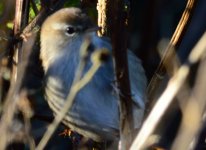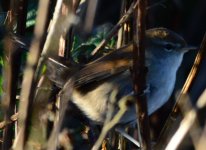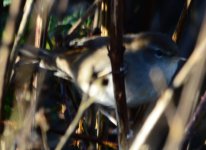RichieTwitchy
YNWA
I'm fairly confident that it is, but id-ing warblers isn't the most easy at times - especially for us colour-blind birders!
So it looks good for Cetti's as it's pretty plain, has a pale supercilium and darker eye stripe with bright eye ring, upright tail and it was skulking around the middle of the bushes.
It didn't make it's familiar call, but it was making long crackling calls followed by shorter brief chirps.
Unfortunately I had a long 500 lens and the bird passed before me at pretty close range but I did managed to aim my camera and reel off a few shots before it disappeared again - hence the out of focus shots. The uploaded photos are cropped.
So just hoping for confirmation from you guys as I always hear these blimmin birds but never get to see them as they're always quick to duck back into cover as soon as I turn my head!
cheers
So it looks good for Cetti's as it's pretty plain, has a pale supercilium and darker eye stripe with bright eye ring, upright tail and it was skulking around the middle of the bushes.
It didn't make it's familiar call, but it was making long crackling calls followed by shorter brief chirps.
Unfortunately I had a long 500 lens and the bird passed before me at pretty close range but I did managed to aim my camera and reel off a few shots before it disappeared again - hence the out of focus shots. The uploaded photos are cropped.
So just hoping for confirmation from you guys as I always hear these blimmin birds but never get to see them as they're always quick to duck back into cover as soon as I turn my head!
cheers









